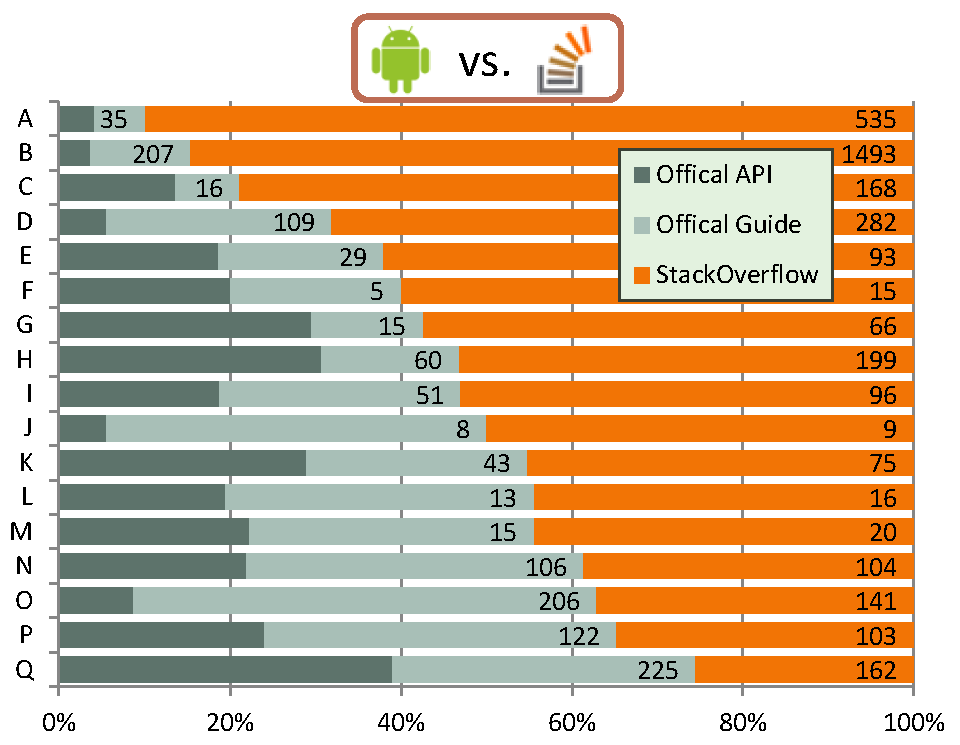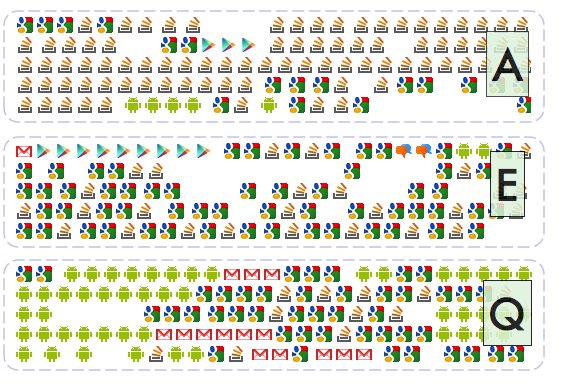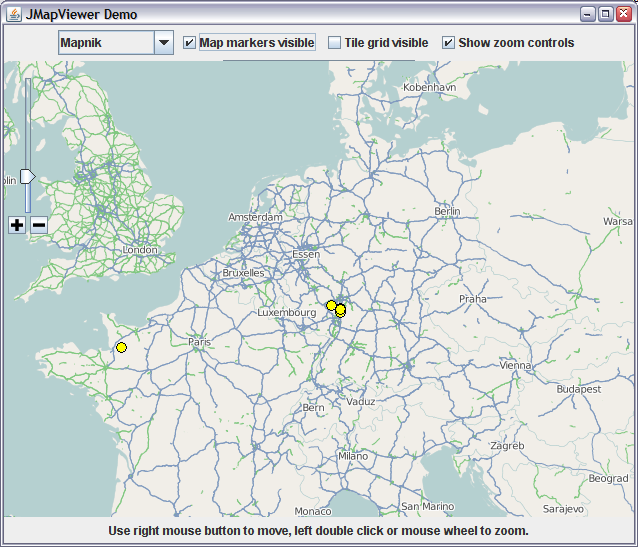Sehr schöner Beitrag unter http://worrydream.com/MagicInk/. Viel Text!
Java EE-Beispiele von Apache TomEE
Siehe https://tomee.apache.org/examples-trunk/index.html:
Session Beans
EntityManagers
CDI
- cdi-basic *
- cdi-request-scope *
- cdi-application-scope *
- simple-cdi-interceptor *
- cdi-produces-disposes
- decorators
- cdi-alternative-and-stereotypes *
EJB
REST
Web Services
JMS and MDBs
Transactions
Security
DataSources
Referencing EJBs
Environment Entries
Java EE Connectors
Testing Techniques
Frameworks
Meta-Annotations
Proxy Beans
EJB Legacy
Other Features
Misc
Google Annotations Gallery: Immer wieder ein Schmunzler
Siehe https://code.google.com/p/gag/:
Disclaimer
- @AhaMoment
- @BossMadeMeDoIt
- @HandsOff
- @IAmAwesome
- @LegacySucks
Enforceable
- @CantTouchThis
- @ImaLetYouFinishBut
Literary Verse (new subcategory)
- @Burma Shave
- @Clerihew
- @DoubleDactyl
- @Haiku (moved to this subcategory)
- @Limerick
- @Sonnet
Remarks
- @Fail
- @OhNoYouDidnt
- @RTFM
- @Win
Team (new category)
- @Blame
- @Channeling
- @Fired
- @HonorableMention
- @Visionary
Türme von Hanoi falsch? Ist wohl die Java-Version schuld
Ich liebe solche Inselrückmeldungen:
Hallo, die Türme von Hanoi funktionieren nicht. Vielleicht ist die Version von Java, die Sie verwendet haben, nicht mehr aktuell.
Anmerkung eines anderen Lesers dazu: http://www.zazzle.com/youre_doing_it_wrong_shirt-235103301417104207
java.awt.SecondaryLoop
Ein GUI-Feature, was die meisten wohl als Neuigkeit in Java 7 übersehen haben: http://sellmic.com/blog/2012/02/29/hidden-java-7-features-secondaryloop/.
Häufchen in Java, und mehr
http://www.fileformat.info/info/unicode/char/1f4a9/index.htm.
PILE OF POO

Noch mehr unter http://www.reddit.com/r/programming/comments/p7rje/unicode_61_is_out_and_it_includes_this_amazing/ und als PDF unter http://www.unicode.org/charts/PDF/U1F300.pdf.
JAPANESE GOBLIN:

BEAR FACE: süüüüüß

The "Java Life" Rap Music Video
Wer es noch nicht kennt:
Quelloffenes Collaboration Tool Phabricator
Von der Webseite http://phabricator.org/:
Phabricator is a suite of web applications that help software companies communicate about software effectively. It was created at Facebook. Phabricator is also used at many other companies such as Airtime,Asana, Dropbox, deviantART, MemSQL, Path, Quora, and more




Gibt es Erfahrung dazu?
API-Dokumentation vs. alternative Dokumentation
Siehe http://blog.ninlabs.com/2013/03/api-documentation/.
Benutzermuster Javadoc vs. Guide vs. StackOverflow verschiedener Entwicklertypen.



Und siehe dann eine ältere Diskussion: http://blog.ninlabs.com/2012/05/crowd-documentation/.
Recommenders 2.0 M1
Updates von der netten Eclipse-Erweiterung Recommenders. Siehe http://www.codetrails.com/blog/eclipse-code-recommenders-20-m1-%E2%80%93-all-signals-green. Das Plugin sortiert in der Vervollständigung nach Häufigkeit.


Video: Wie Dropbox skaliert
Bit-Trickserei in C
The Aggregate Magic Algorithms, http://www.aggregate.org/MAGIC/, vieles davon ist übertragbar auf Java, wie man auch vereinzelt in den Wrapper-Klassen ablesen kann.
JD Eclipse plugin
JMapViewer, einfache Komponenten für OpenStreepMap Karte
Siehe http://wiki.openstreetmap.org/wiki/JMapViewer.
- Provides integrated zoom controls (slider and buttons) in the left upper corner (can be hidden)
- Switch between different tile sources: Mapnik, Tiles@Home, Cyclemap, … (other tiled maps can be used, too)
- Configurable in-memory and file-based caching of loaded map tiles
- A list of map markers (the yellow circles in the screenshot) can be added. Map markers of different shape can be easily added by implementing the MapMarker interface.
- Configurable/Extentable/Replaceable controller (code part that manages mouse interaction and how the map reacts to it)
- Requirement: Java 1.6
- License: GPL
- Subversion repository: http://svn.openstreetmap.org/applications/viewer/jmapviewer
- The repository is an Eclipse project which can be directly checked out. Additionally a build.xml for compiling and packaging via Apache Ant is present in the repository.
- http://josm.openstreetmap.de/doc/index.html?org/openstreetmap/gui/jmapviewer/JMapViewer.html

Apache ODF Toolkit in Release 0.6
Aus dem Changelog https://www.apache.org/dist/incubator/odftoolkit/CHANGES-0.6-incubating.txt:
* Added document encryption support
* Added metadata support
* Support for OpenDocument-v1.2
* Additional APIs for Simple API
Zum Projekt selbst sagt die Homepage:
The Apache ODF Toolkit is a set of Java modules that allow programmatic creation, scanning and manipulation of Open Document Format (ISO/IEC 26300 == ODF) documents. Unlike other approaches which rely on runtime manipulation of heavy-weight editors via an automation interface, the ODF Toolkit is lightweight and ideal for server use.
Dokumente sind leicht erstellt, siehe https://incubator.apache.org/odftoolkit/simple/gettingstartguide.html:
import java.net.URI;
import org.odftoolkit.simple.TextDocument;
import org.odftoolkit.simple.table.Cell;
import org.odftoolkit.simple.table.Table;
import org.odftoolkit.simple.text.list.List;
public class HelloWorld {
public static void main(String[] args) {
TextDocument outputOdt;
try {
outputOdt = TextDocument.newTextDocument();
// add image
outputOdt.newImage(new URI("odf-logo.png"));
// add paragraph
outputOdt.addParagraph("Hello World, Hello Simple ODF!");
// add list
outputOdt.addParagraph("The following is a list.");
List list = outputOdt.addList();
String[] items = {"item1", "item2", "item3"};
list.addItems(items);
// add table
Table table = outputOdt.addTable(2, 2);
Cell cell = table.getCellByPosition(0, 0);
cell.setStringValue("Hello World!");
outputOdt.save("HelloWorld.odt");
} catch (Exception e) {
System.err.println("ERROR: unable to create output file.");
}
}
}
UML-Diagramme mit ObjectAid für Eclipse
Von http://www.objectaid.com/:
The ObjectAid UML Explorer is an agile and lightweight code visualization tool for the Eclipse IDE. It shows your Java source code and libraries in live UML class and sequence diagrams that automatically update as your code changes. The image below is a class diagram of actual source code; click on it to see the editor in the Eclipse Java Perspective

Ein kleines HOWTO unter http://fuzz-box.blogspot.de/2012/09/how-to-generate-uml-diagrams-from-java.html?m=1.
Link: Things That Turbo Pascal is Smaller Than
http://prog21.dadgum.com/116.html. Wie die Zeiten sich doch ändern….
Wie Default-Methoden in Java 8 implementiert werden
http://cr.openjdk.java.net/~kamg/default_methods_in_hotspot.txt. Schon etwas älter, muss nicht mehr der neuste Stand sein!
Link: Devoxx 2012: Java 8 Lambda and Parallelism, Part 2
http://download.java.net/jdk8/docs/api/java/util/concurrent/locks/StampedLock.html
Neue Klasse in Java 8. Implementiert jedoch nicht Lock, wie es ReentrantLock tut. Aus der API:
A capability-based lock with three modes for controlling read/write access. The state of a StampedLock consists of a version and mode. Lock acquisition methods return a stamp that represents and controls access with respect to a lock state; "try" versions of these methods may instead return the special value zero to represent failure to acquire access. Lock release and conversion methods require stamps as arguments, and fail if they do not match the state of the lock. The three modes are:
- Writing. Method
writeLock()possibly blocks waiting for exclusive access, returning a stamp that can be used in methodunlockWrite(long)to release the lock. Untimed and timed versions oftryWriteLockare also provided. When the lock is held in write mode, no read locks may be obtained, and all optimistic read validations will fail.- Reading. Method
readLock()possibly blocks waiting for non-exclusive access, returning a stamp that can be used in methodunlockRead(long)to release the lock. Untimed and timed versions oftryReadLockare also provided.- Optimistic Reading. Method
tryOptimisticRead()returns a non-zero stamp only if the lock is not currently held in write mode. Methodvalidate(long)returns true if the lock has not been acquired in write mode since obtaining a given stamp. This mode can be thought of as an extremely weak version of a read-lock, that can be broken by a writer at any time. The use of optimistic mode for short read-only code segments often reduces contention and improves throughput. However, its use is inherently fragile. Optimistic read sections should only read fields and hold them in local variables for later use after validation. Fields read while in optimistic mode may be wildly inconsistent, so usage applies only when you are familiar enough with data representations to check consistency and/or repeatedly invoke methodvalidate(). For example, such steps are typically required when first reading an object or array reference, and then accessing one of its fields, elements or methods.This class also supports methods that conditionally provide conversions across the three modes. For example, method
tryConvertToWriteLock(long)attempts to "upgrade" a mode, returning a valid write stamp if (1) already in writing mode (2) in reading mode and there are no other readers or (3) in optimistic mode and the lock is available. The forms of these methods are designed to help reduce some of the code bloat that otherwise occurs in retry-based designs.StampedLocks are designed for use as internal utilities in the development of thread-safe components. Their use relies on knowledge of the internal properties of the data, objects, and methods they are protecting. They are not reentrant, so locked bodies should not call other unknown methods that may try to re-acquire locks (although you may pass a stamp to other methods that can use or convert it). The use of read lock modes relies on the associated code sections being side-effect-free. Unvalidated optimistic read sections cannot call methods that are not known to tolerate potential inconsistencies. Stamps use finite representations, and are not cryptographically secure (i.e., a valid stamp may be guessable). Stamp values may recycle after (no sooner than) one year of continuous operation. A stamp held without use or validation for longer than this period may fail to validate correctly. StampedLocks are serializable, but always deserialize into initial unlocked state, so they are not useful for remote locking.
The scheduling policy of StampedLock does not consistently prefer readers over writers or vice versa. All "try" methods are best-effort and do not necessarily conform to any scheduling or fairness policy. A zero return from any "try" method for acquiring or converting locks does not carry any information about the state of the lock; a subsequent invocation may succeed.
Because it supports coordinated usage across multiple lock modes, this class does not directly implement the
LockorReadWriteLockinterfaces. However, a StampedLock may be viewedasReadLock(),asWriteLock(), orasReadWriteLock()in applications requiring only the associated set of functionality.


